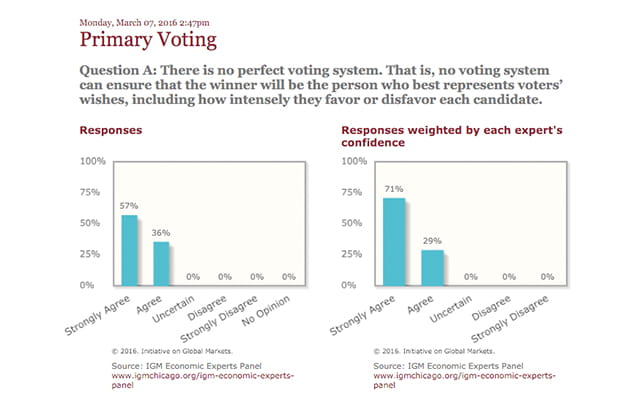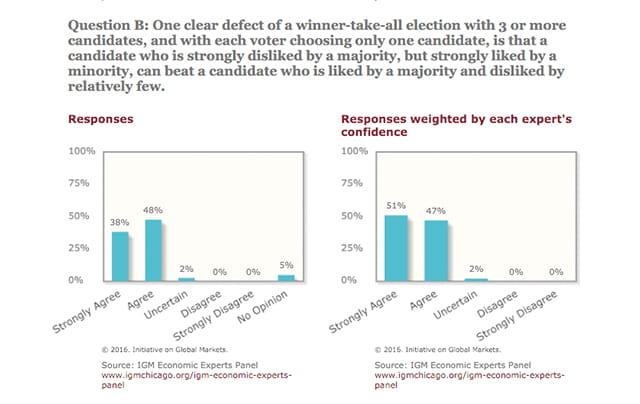What Economists Think about Voting
- By
- March 08, 2016
- CBR - Economics
The United States’ 2016 presidential primaries have yielded a bumper crop of commentary from political observers, including speculation of a contested Republican convention, a major third-party candidate in the general election, and the prospect that the US Congress may eventually choose the winner. Any of those scenarios could raise questions about the essential fairness of the American electoral process. But while the election may reveal some seldom-seen complications, quirks, or outright flaws of the US voting system, Kenneth Arrow’s famous Impossibility Theorem suggests that all electoral systems fall short of guaranteeing perfectly fair results. Is there any exception?
Chicago Booth’s Initiative on Global Markets turned to its own voting process, a poll of the Economic Experts Panel, to find out. Is there such a thing as a perfect voting system? The respondents were unanimous in their insistence that there is not. Does the presence of more than three candidates present a “clear defect” in a winner-take-all, one-vote-per-person system? Eighty-six percent of the panel said it does.
Question A: There is no perfect voting system. That is, no voting system can ensure that the winner will be the person who best represents voters’ wishes, including how intensely they favor or disfavor each candidate.

Oliver Hart of Harvard strongly agreed and was one of numerous respondents to cite Arrow’s research: “We know from Arrow's impossibility theorem that no voting system can aggregate preferences perfectly even if people vote honestly.”
José Scheinkman of Princeton agreed, but pointed out some systems are better than others: “However, alternatives that allow for multiple votes per person can achieve outcomes that better reflect intensity of opinions.”
Question B: One clear defect of a winner-take-all election with 3 or more candidates, and with each voter choosing only one candidate, is that a candidate who is strongly disliked by a majority, but strongly liked by a minority, can beat a candidate who is liked by a majority and disliked by relatively few.

Aaron Edlin of the University of California at Berkeley agreed: “I would say ‘imperfection,’ not ‘defect.’ Compared to what, though, is the question, as there is no perfect system.”
William Nordhaus of Yale agreed and suggested a solution: “[A] single transferable vote would overcome this problem.”
Your Privacy
We want to demonstrate our commitment to your privacy. Please review Chicago Booth's privacy notice, which provides information explaining how and why we collect particular information when you visit our website.